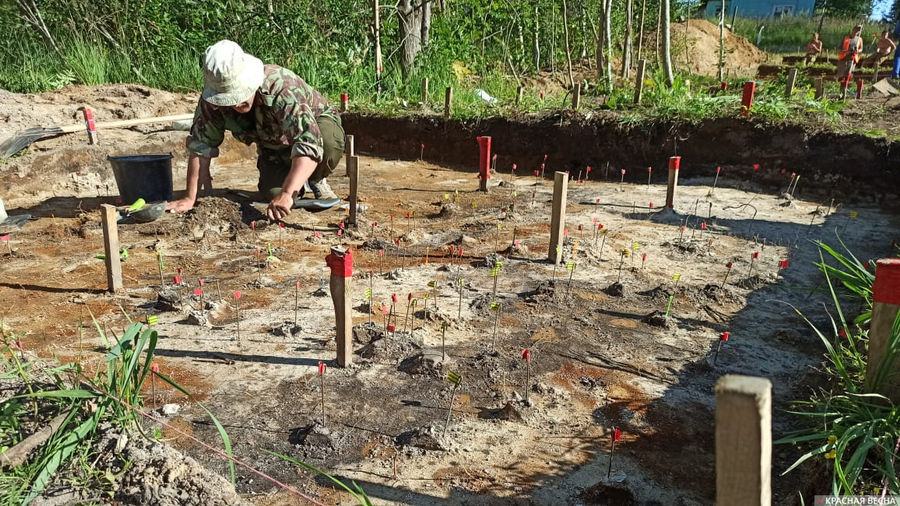
An interesting discovery from the Bronze Age – the grave of an ancient metallurgist – was made by archaeologists from the South Ural State University (SUSU), the press service of the university reported on August 5.
The burial was discovered in the Troitsky district of the Chelyabinsk region, in the Krivoye Ozero area during an expedition to excavate burials of the Sintashta culture (21st-18th centuries BC). The study of the burial was carried out within the framework of the Russian Science Foundation project “Migrations of human groups and individual mobility within the framework of a multidisciplinary analysis of archaeological information (Bronze Age of the Southern Urals)”.
The scientists presented the results of the excavations in the article “Did metalworkers travel? Interdisciplinary analysis of a metalworker’s burial in the Late Bronze Age Krivoe Lake necropolis (Southern Trans-Urals, Russia),” published in the Springer Verlag journal Archaeological and Anthropological Sciences.
The director of the Institute of Mass Media, Social Sciences and Humanities (IMSHN) of SUSU, Doctor of Historical Sciences Andrei Epimakhov, spoke about the investigation of the find.
One of the main concepts in archaeology is the concept of archaeological cultures, which are distinguished by common rituals, beliefs, geography of residence and kinship. In the Southern Urals, in the early 1960s and 1970s, archaeologists discovered the Bronze Age Sintashta culture, which includes the famous Arkaim and dozens of other settlements: Sintashta, Ustye, Kamenny Ambar, Stepnoye and some others.
Among the burial grounds found in these settlements is the Krivoye Ozero necropolis, explored in the 1990s by Doctor of Historical Sciences Nikolai Vinogradov. However, modern analytical capabilities allowed SUSU scientists to take a completely different look at one of the burials, which contained evidence of the metallurgical activity of the buried person.
The time of burial according to radiocarbon dating is 1996-1881 BC. The burial ritual is typical of the Sintashta people in terms of the position of the body and the sacrifices. It was clearly not an outcast who was buried, but a full member of society. The grave is located under the same mound as other members of the ancient collective.
Dietary analysis based on nitrogen and carbon isotopes in the bones showed that this person ate the same foods as others buried at Crooked Lake Necropolis, meaning he lived with them in the same area.
He, like other craftsmen, was buried together with materials and tools. His grave contained minerals, scrap metal for smelting and fragments of slag cakes, suggesting that the man was an ancient metallurgist.
His unusual appearance is interesting. The skull of this craftsman speaks of a genetic disease – acromegaly, which makes facial features rough. His height, the average for the Sintashta people, was about 170 centimeters, and in terms of age he was over 50 years old, which for that time meant longevity. His highly developed muscles in the upper part of his shoulders indicated physical work.
Archaeologists can use the ratio of strontium-87/86 isotopes in bones and tooth enamel to determine where a person spent a significant part of their life, as this indicator varies in different geographic locations. The archaeologists plotted this data on a map.
This analysis, carried out for the former metallurgist, gave researchers the first surprise: it turned out that although he was buried in the Krivoye Ozero cemetery, his strontium isotope ratio was the same as those buried in the Solntse II cemetery, part of the Arkaim nature reserve.
That is, this person had at some point changed his place of residence, travelling a distance of at least 100 kilometres. Apart from the metalworker, out of the 40 buried in the Kryvyi Ozera cemetery, only one person was not a local. This was a man in whose grave the remains of a car were found.
The second surprise for scientists was the analysis of mineral samples. Thus, they identified tourmaline, which ancient people mined in Mugodzhary, in the area of present-day Elenovka. That is, the mineral was mined 300 kilometers from the burial site. Mugodzhary is a continuation of the Ural mountain range in Kazakhstan.
The fact that the metallurgist turned out to be an alien reminded Andrei Epimakhov and his colleagues of the hypothesis put forward by archaeologist Gordon Childe in the 1930s. Child believed that metallurgists wandered, cherishing the secrets of their art, and that metal smelting was considered not just a craft, but magical and sacred knowledge.
Although the data obtained by the Chelyabinsk archaeologists are probably not enough to confirm Child’s hypothesis, the information they obtained using new methods partially confirms it. However, this leaves scientists with an unsolved mystery: how the master from Arkaim ended up on the banks of the Uy River – perhaps he was invited, perhaps he was captured, or there was another reason for his transfer.
The research of Chelyabinsk archaeologists under the leadership of Andrey Epimakhov continues using the most modern methods, when excavations are combined with radiocarbon dating, strontium isotope analysis, electron microscopy and LA-ICP-MS (inductively coupled plasma mass spectrometry) analysis.
At the same time, archaeologists complement the use of technical achievements with a scrupulous study of the funeral ritual, resulting in more detailed and conclusive information about the Sintashta culture of the ancient Southern Urals.
Source: Rossa Primavera
I am Michael Melvin, an experienced news writer with a passion for uncovering stories and bringing them to the public. I have been working in the news industry for over five years now, and my work has been published on multiple websites. As an author at 24 News Reporters, I cover world section of current events stories that are both informative and captivating to read.
